Gearing up for a bountiful pumpkin harvest? Look no further. This guide unveils the crème de la crème of pumpkin varieties that promise a vibrant garden and lucrative returns. From classic giants to unique heirlooms, we’ve curated a list of the top 20 pumpkin varieties that hold the key to high profits. Whether seasoned gardener or just starting, these meticulously selected options will pique your interest and cultivate success.
Pumpkin Basic Terms
In the realm of pumpkins, several terms define their characteristics. The skin, the outer layer adorned with hues, conceals the true nature within. The flesh, vital for culinary creations, resides within the pumpkin’s core. Capability gauges ease of manipulation, determining whether it’s suitable for carving or better left unscathed for artistic expression.
Shapes diverge from traditional roundness, embracing diversity in squatness, height, and length. Texture, a tactile indulgence, ranges from bumpy to smooth. Ribbing, akin to a pumpkin’s signature stripes, sets it apart. Size matters, spanning from diminutive to massive, often linked to weight. Lastly, its longevity, whether stalwart or fleeting, defines its journey from vine to shelf.
Factors to Consider for Pumpkin Varieties to Grow in Your Garden
Climate Suitability: Pumpkin varieties exhibit varying tolerance to temperature and growing conditions. Some thrive in warm climates, while others endure cooler regions. Choose a variety aligned with your local climate to ensure optimal growth and yield.
Maturity Period: The duration from planting to harvest significantly varies among pumpkin types. From 85 to 120 days, this period determines when you can reap your rewards. Factor in your growing season length to select a variety that matures within your available timeframe.
Space Requirements: Pumpkins span a spectrum of sizes, demanding distinct space allocations. Compact bushes fit well in limited spaces, whereas sprawling varieties need ample room. Evaluate your garden layout and choose pumpkins that won’t overpower or crowd neighboring plants.
Yield Potential: Pumpkin yields vary, with some producing just a few fruits and others generating a bountiful harvest. Assess your needs and garden capacity. High-yielding types require more space and resources, while smaller yields could be more manageable for beginners.
Disease Resistance: Pests and diseases can damage pumpkin plants. Research varieties with inherent resistance to common issues in your area. This can reduce the need for chemical interventions and contribute to a healthier garden ecosystem.
Intended Use: Define the purpose of your pumpkins—culinary delights, decorations, or both. Some varieties boast delectable flesh, while others excel in size and shape for carving. Clarify your goals to choose a variety that aligns with your garden’s intended output.
Flavor and Culinary Value: Flavor matters if you’re growing pumpkins for consumption. Sugar pumpkins are revered for their sweet, smooth flesh, ideal for pies. Larger pumpkins may lack a fine texture but can still be used in soups and dishes.
Storage Longevity: Pumpkins with extended shelf lives stay fresh after harvest. This is essential if you store them for culinary use or festive decor. Varieties with robust, thick skins tend to preserve well, providing lasting value.
Growth Habit: Pumpkin vines exhibit bush, semi-bush, and vining growth patterns. Bush types require less space and support, while vining varieties can sprawl across your garden. Select a growth habit that aligns with your garden design and available infrastructure.
Aesthetic Appeal: Pumpkins come in diverse colors, shapes, and sizes, adding visual to garden and autumn decor. Whether you prefer classic orange or unique hues like white, blue, or striped, choose pumpkins that resonate with your aesthetic preferences.
Top 20 Pumpkin Varieties to Grow in Your Garden
Cinderella
Cinderella pumpkin, also known as Cucurbita maxima, is popular with a vibrant reddish-orange hue and a flattened, deeply ribbed shape resembling the fairy tale pumpkin carriage. Its mild sweetness and smooth texture make it perfect for culinary creations and decorations. Cinderella pumpkins yield around 10 to 20 pounds per fruit and thrive in warm climates with ample sunlight and well-draining soil.
In case you missed it: Top 20 Apple Varieties in India: List of Apple Varieties to Grow for High Profits
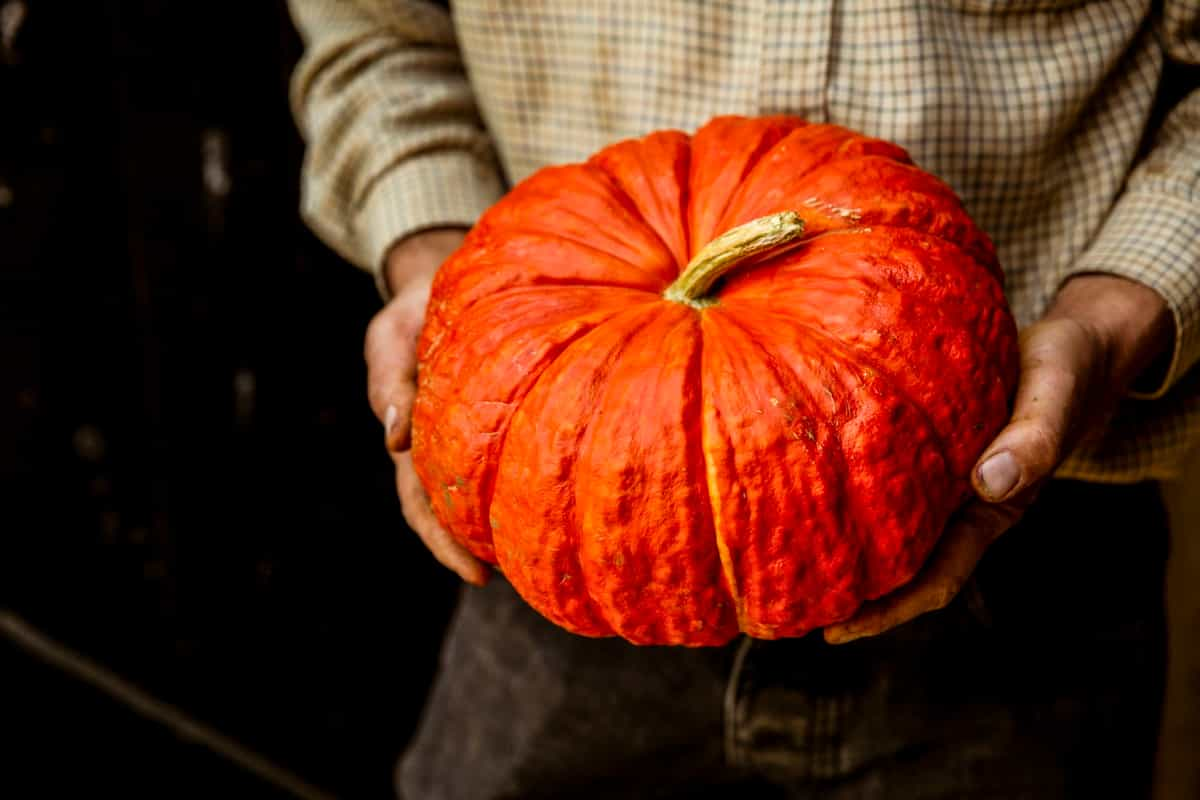
They require space to spread their vines, which can span up to 15 feet. To cultivate, plant seeds after the last frost date, provide adequate spacing, and ensure regular watering and fertilization. Harvesting and storage are crucial, with the pumpkins being harvested once their color is rich and consistent, leaving a few inches of stem attached for longevity.
Atlantic Giant
The Atlantic Giant pumpkin variety is known for its colossal size and distinctive traits. It features vigorous vines and lush greenery, making it a luxurious garden addition. The variety can yield pumpkins of extraordinary proportions, with recorded weights exceeding 1,500 pounds in competitions.
In standard garden conditions, they can grow from 100 to 300 pounds. The Atlantic Giant thrives in temperate climates and requires abundant sunlight for optimal growth. Its native North American origins make it suitable for regions with warm summers. Cultivating Atlantic Giants requires dedicated care, including regular watering, nutrient-rich soil, and pest management.
Connecticut Field
The Connecticut Field pumpkin variety is popular for gardeners due to its warm orange hue and rich history. Its sprawling vines cover large areas, yielding large, round pumpkins weighing 15 to 25 pounds. These pumpkins are valued for their tough skin and are suitable for carving and long-term display.
They thrive in sun and well-draining soil, ideal for large garden spaces or open fields. Harvesting occurs in 100 to 120 days, providing a splendid autumn harvest. Connecticut Field pumpkins are hardy and resilient, with minimal susceptibility to common pests and diseases.
Baby Boo
Baby Boo pumpkins are charming miniature pumpkins with a striking white hue, typically reaching 3 to 4 inches in diameter. They have generous yield potential, producing 10 to 15 miniatures per plant. They thrive in warm climates, preferring well-drained soil for healthy growth. They can be grown in garden beds and containers, making them versatile for various spaces.
In case you missed it: How to Start Pumpkin Farming in the USA: A Step-By-Step Planting to Harvesting Guide
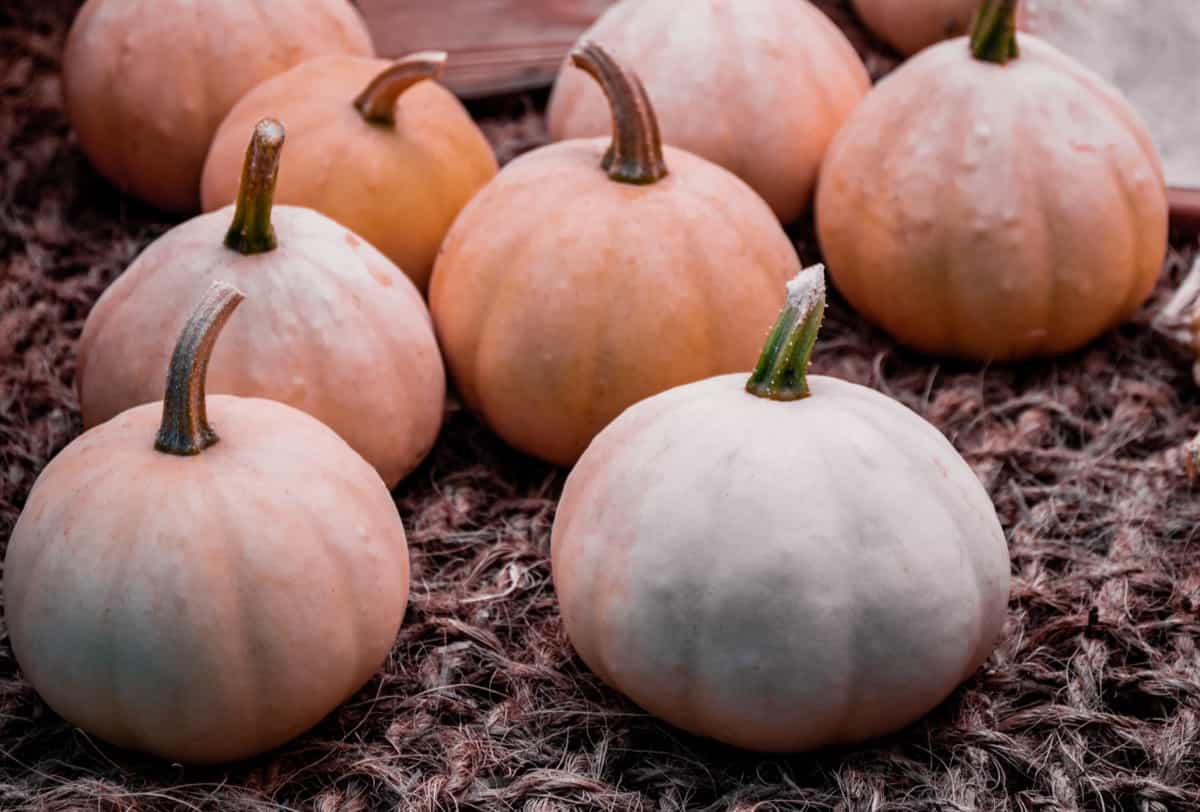
The maturity period for Baby Boo pumpkins is 90 to 100 days, making them a waiting game. Their striking white color adds a unique touch to gardens and pairs well with larger ones. They are highly prized for decorative purposes, especially as table centerpieces. They are also child-friendly, as their small size and attractive appearance make them perfect for children to engage with, encouraging a love for gardening from a young age.
Jarrahdale
The Jarrahdale pumpkin, originating from Australia, is a unique variety with a distinctive blue-gray skin that resembles a rustic heirloom. Its dense, fine-textured flesh is perfect for culinary adventures. The pumpkins weigh 6 to 10 kilograms when mature and have an oblong shape resembling a flattened globe.
They thrive in warm climates with full sun exposure and prefer well-draining soil. Mature time is 90 to 100 days, and the blue-gray skin deepens as it grows. Jarrahdale pumpkins are also known for their excellent storage longevity, allowing them to be enjoyed beyond the harvest season. Their robust skin protects the tender flesh, making them a versatile addition to any garden.
Sugar Pie
Sugar Pie pumpkin, or Cucurbita pepo, is a compact variety suitable for small spaces with moderate vines that spread 6 to 10 feet, yielding 6-8 inch pumpkins. It thrives in well-drained soil with ample sunlight, making it an excellent choice for gardens across North America, especially in USDA zones 3-9. Sugar Pie pumpkins are known for their exceptional sweetness and fine-textured flesh, making them perfect for classic pumpkin pies, rich soups, and delectable purees.
Harvest and storage take 85-100 days, with a firm, deep orange skin indicating readiness. Sugar Pies have a good shelf life of up to 3 months can store in a cool, dry place. They are well-suited for small gardens or container cultivation, with attractive vines and vibrant fruits adding aesthetic value to any garden landscape. Provide well-draining soil, consistent watering, and proper spacing for optimal growth.
Jack Be Little
The Jack Be Little pumpkin variety is popular for gardens and fall displays due to its compact vines and charming orange hue. Grown in USDA Hardiness Zones 3-9, it thrives in full sun and well-draining soil. Its bush-like growth habit makes it ideal for small gardens or container gardening.
In case you missed it: Top 17 Steps/Ways to Boost Pumpkin Yield: How to Increase Production, Size, and Quality
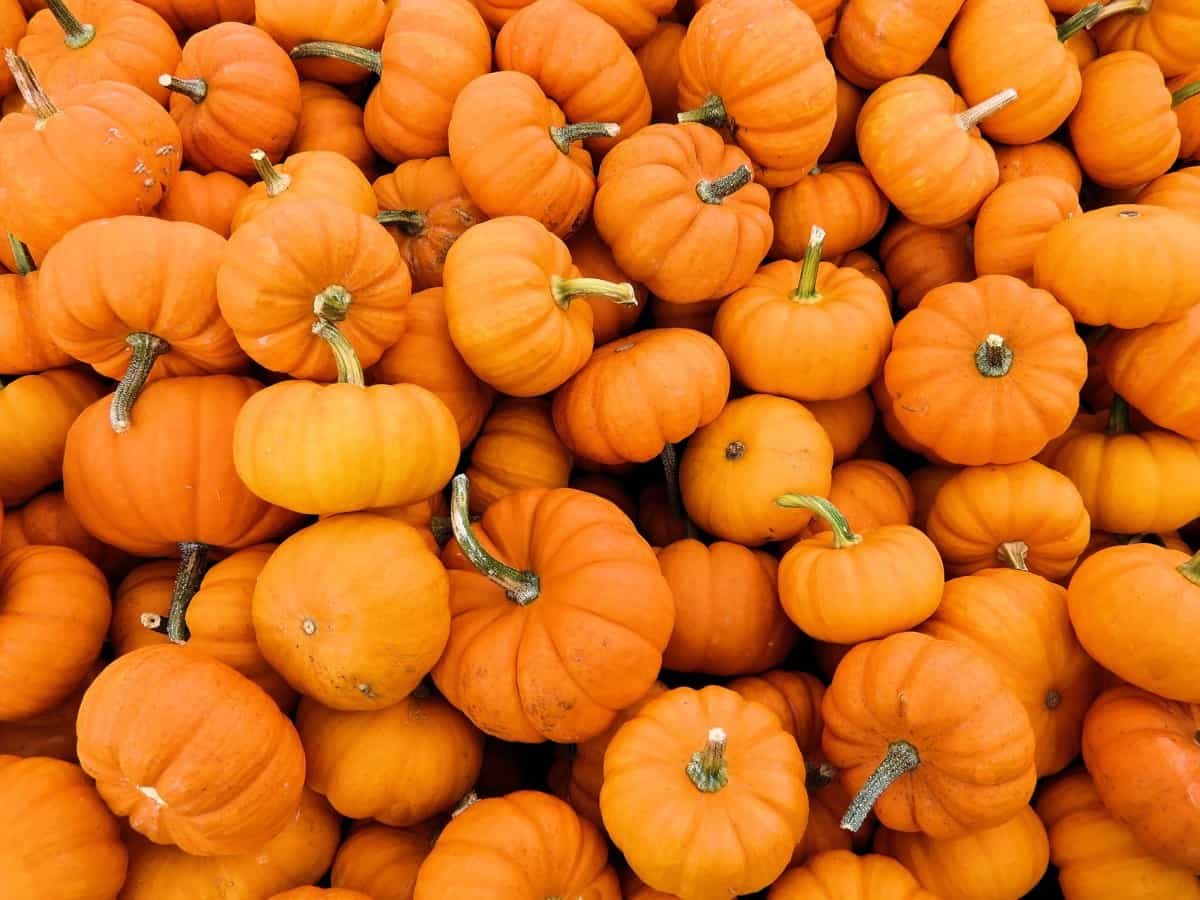
Despite its small size, these pumpkins yield multiple fruits per vine, making them perfect for carving intricate designs or culinary creations. Their sweet and tender flesh makes them ideal for stuffing, roasting, or incorporating into various dishes. With a long storage life, these pumpkins can be enjoyed beyond harvest, adding a touch of elegance to your autumn table.
Howden
The Howden pumpkin, or Cucurbita pepo, is a popular vine variety with a deep orange hue and classic pumpkin shape. It thrives in temperate climates and can produce 10 to 15 fruits weighing 20 to 25 pounds. Despite not being primarily bred for consumption, Howden pumpkins can be used in various culinary creations, such as soups and pies. Their textured skin adds rustic charm to autumn displays.
In case you missed it:
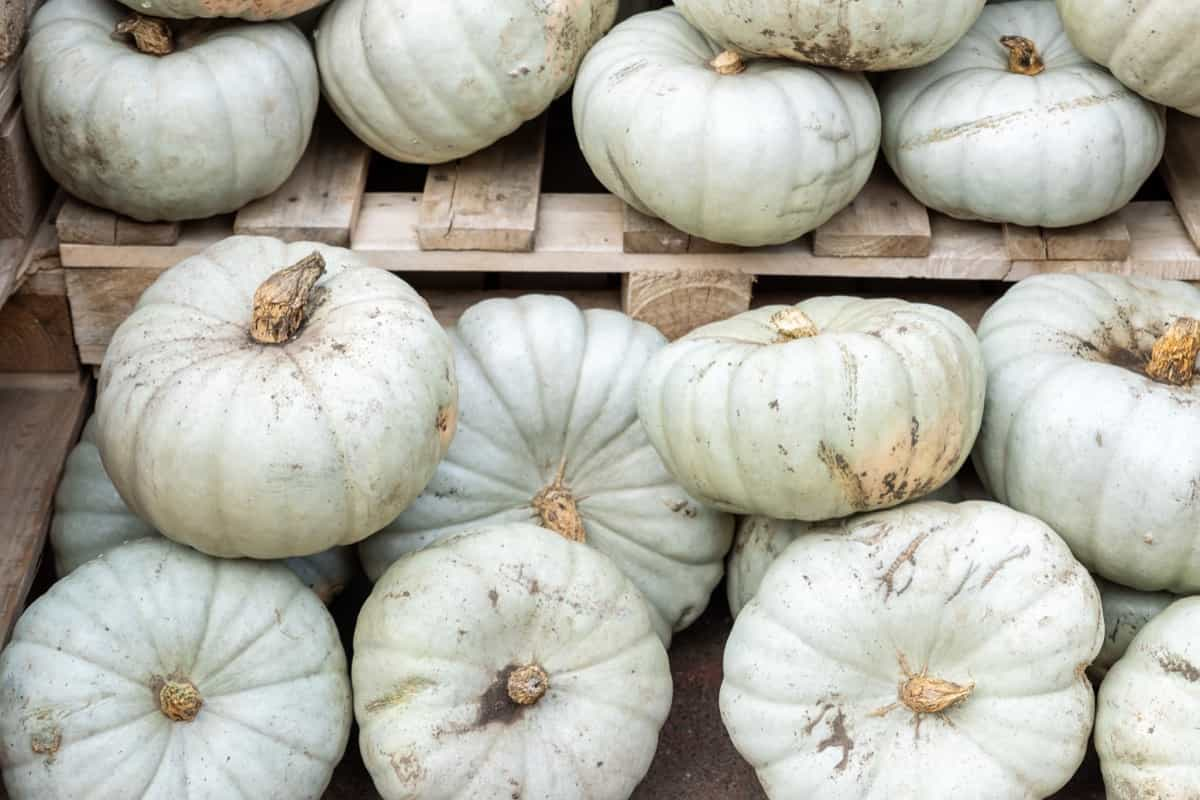
The Howden pumpkin’s attractive appearance makes it a staple for autumn decorations. To cultivate thriving Howden pumpkins, sow seeds after the last frost date in well-draining soil enriched with compost, maintain consistent moisture, and ensure adequate spacing between plants. Harvest Howden pumpkins around 100 to 110 days after planting when the skin hardens and develops a deep color.
Long Island Cheese
The Long Island Cheese pumpkin variety, named after its cheese-like shapes, is popular with gardeners and food enthusiasts due to its creamy, pale orange skin and robust flesh. A single plant can yield 2 to 3 pumpkins, weighing 5 to 7 pounds. Originating from Long Island, New York, this variety thrives in warm, sunny spaces with well-drained soil. Plant seeds after frost, as they take 100 to 110 days to reach their full, cheese-like glory.
Musquee de Provence
Musquee de Provence is a French heirloom pumpkin variety with distinctive ridges and a deep salmon hue. It weighs 10-20 pounds and is perfect for savory dishes and sweets like pies and soups. This versatile variety thrives in warmer climates, in full sun and well-drained soil, and requires ample space for vines to stretch. The extended growing season of 110-120 days from planting to harvesting is a key charm, with its alluring flavor often described as a harmonious blend of chestnuts and sweet potatoes.
In case you missed it: Top 20 Lettuce Varieties to Grow in Your Garden: Best List for Backyard for Fall and Winter
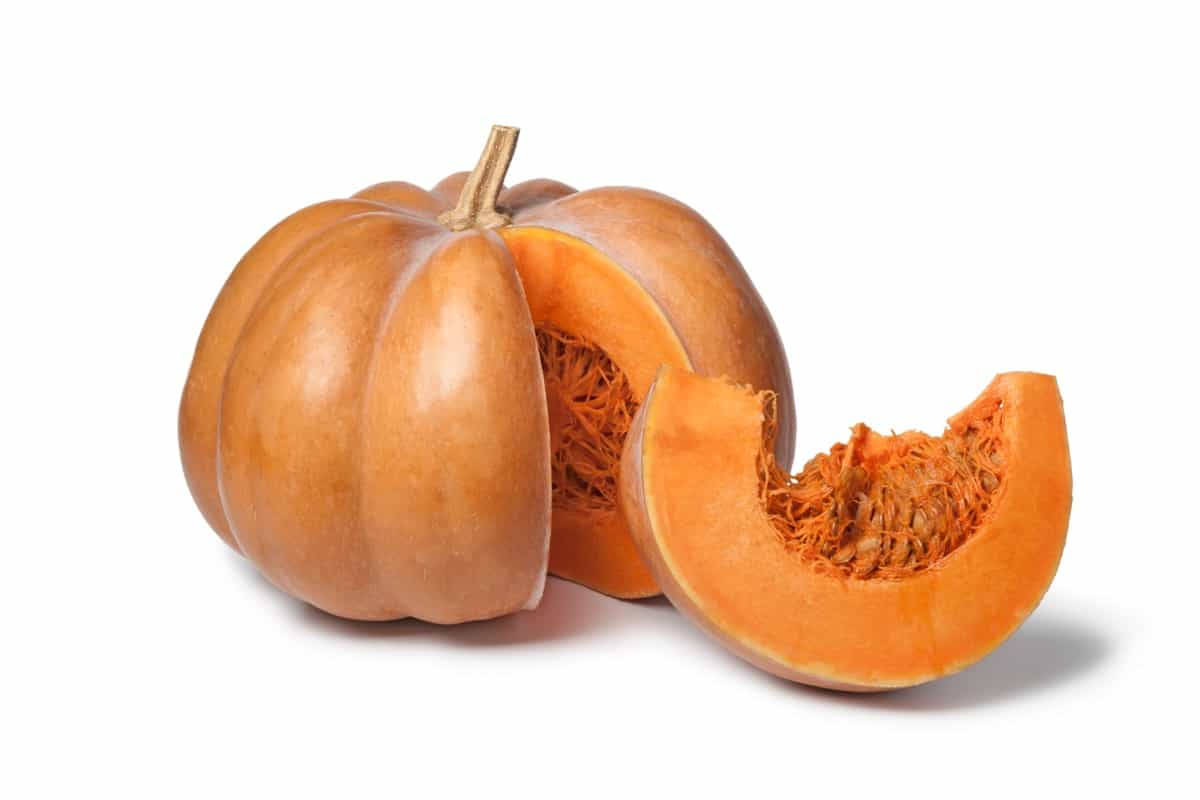
Fairytale
Fairytale pumpkins, also known as Cinderella or “Rouge Vif d’Etampes,” are a garden masterpiece with a flattened, deeply ribbed form resembling a fairy tale carriage. They thrive in well-drained soil, requiring ample sunlight and warm temperatures. They are also perfect for cooking and baking, making them perfect for soups, pies, and desserts.
To cultivate and care for, start seeds indoors in early spring and transplant them outdoors after frost danger passes. Adequate spacing, consistent watering, and occasional fertilization support growth. Fairytale pumpkins are ready for harvest in around 100 days and should be cured in a warm, dry spot for two weeks. Properly stored, they can last for several months.
Galeux d’Eysines
The Galeux d’Eysines pumpkin variety, also known as the “Peanut Pumpkin,” is popular with gardeners and enthusiasts due to its unique appearance and texture. Originating in Bordeaux region of France, it yields an average of 2 to 4 fruits per plant and can weigh between 10 to 20 pounds. It is known for its rich, sweet taste and smooth, non-stringy flesh, making it an excellent choice for savory dishes and decorative pieces. Growing tips include sowing seeds after the last frost date, regular watering, and gentle handling.
Lumina
Lumina pumpkins, scientifically known as Cucurbita maxima, stand out with their strikingly pale, ghostly white skin. These pumpkins thrive in warm climates and require ample sunlight. They exhibit a vining growth habit with vines spanning 15 to 20 feet. Lumina pumpkins are lauded for their versatility, ideal for culinary and decorative purposes. Their tender, flavorful flesh lends itself well to soups and pies. On average, these pumpkins yield around 2 to 3 fruits per plant.
In case you missed it: Top 20 Grape Varieties to Grow in India: List of Grape Varieties to Grow for High Profits
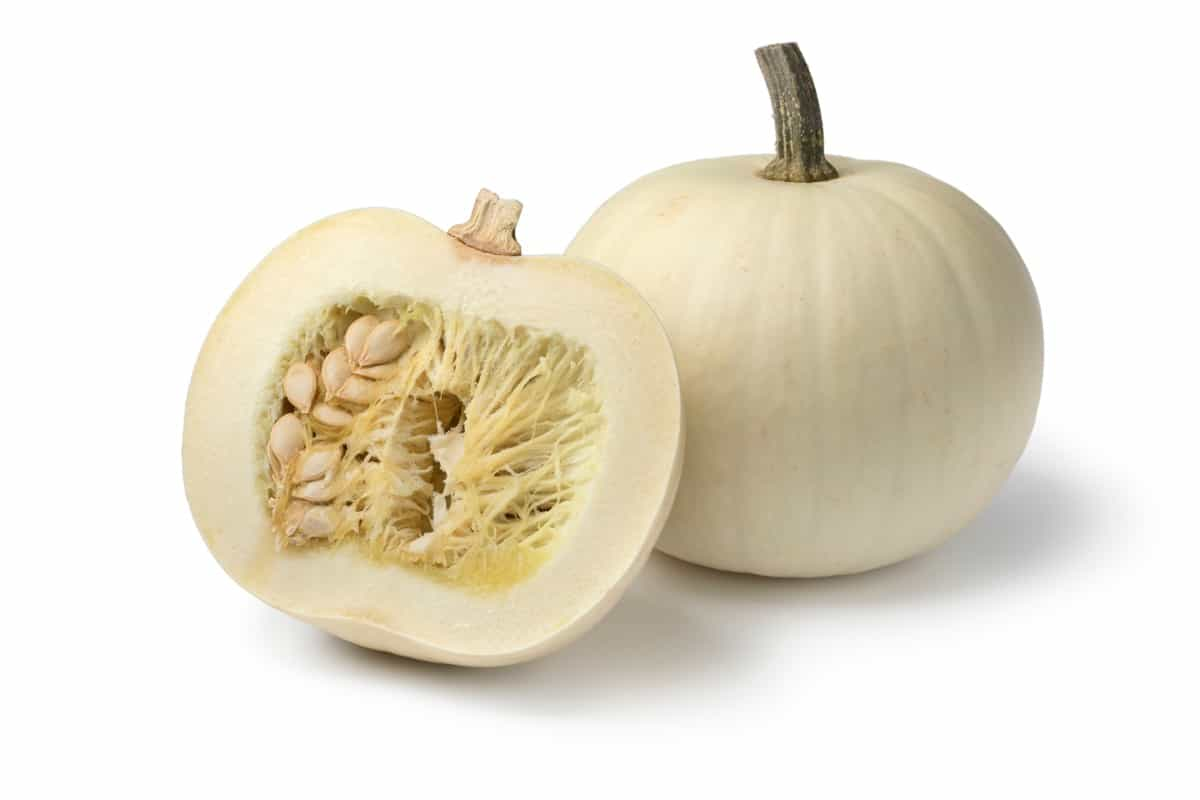
Blue Hubbard
The Blue Hubbard pumpkin variety, known for its bluish-gray skin and sweet flesh, yields 10-20 pounds per pumpkin. It thrives in sunlight and well-drained soil, and its sprawling vines produce large, ornate fruits. This variety tells a tale of taste and tradition, inviting you to cultivate its rich legacy.
Marina di Chioggia
The Marina di Chioggia pumpkin variety, originating from Italy’s coastal town, is a unique heirloom with bumpy skin and a bluish-green hue. Known for its sweet flesh, it’s perfect for culinary adventures and requires ample space for growth.
Big Max
The Big Max pumpkin variety, a giant pumpkin often exceeding 100 pounds, is known for its deep orange hue and carving abilities. It thrives in well-draining soil and sunny locations, making it a popular decoration during fall festivities.
Kakai
The Kakai pumpkin, an Austrian heirloom, is a festive and festive choice with vibrant orange and green stripes. Its hull-less seeds are perfect for snacking, and its fine-textured flesh is perfect for soups and pies. It thrives in zones 3-9.
Munchkin
Munchkin pumpkins, a charming and colorful miniature, are perfect for decor and cooking. With a 2 to 4-inch diameter and vibrant orange skin, they thrive in sunny gardens and can produce 10 to 15 fruits per plant, adding whimsy and flavor to your harvest.
Porcelain Doll
The Porcelain Doll is a unique pumpkin variety with pastel pink skin, moderate yield, and full sunlight. It thrives in warm climates and requires space due to its vining nature. It adds whimsy to fall displays.
Wee-B-Little
Wee-B-Little pumpkins are small, vibrant miniatures with ridges and smooth texture, ideal for ornamental and culinary use. They thrive in warm climates with full sun exposure and well-draining soil. They are suitable for various garden sizes and can be grown in gardens or containers. They are also popular as decorative accents for fall displays and centerpieces. To grow, plant seeds directly after the last frost date, provide regular water and ensure proper spacing. Harvest time is 90-100 days after planting.
Conclusion
In pumpkin cultivation, the top 20 varieties stand as a tapestry of diversity, offering both ornamental allure and culinary prowess. Cultivating these gems can lead to a vibrant garden and the potential for fruitful profits.
- How to Build a Low-budget Goat Shed: Cheap Ideas and Tips
- Goat Farming Training Programs in India: A Beginner’s Guide
- Types of Pesticides Used in Agriculture: A Beginner’s Guide
- Economical Aquaculture: A Guide to Low-Budget Fish Farming
- 15 Common Planting Errors That Can Doom Your Fruit Trees
- How to Make Houseplants Bushy: Effective Tips and Ideas
- Innovative Strategies for Boosting Coconut Pollination and Yield
- Pollination Strategies for Maximum Pumpkin Yield
- The Complete Guide to Chicken Fattening: Strategies for Maximum Growth
- Natural Solutions for Tulip Problems: 100% Effective Remedies for Leaf and Bulb-Related Issues
- Revolutionizing Citrus Preservation: Towards a Healthier, Greener Future
- Natural Solutions for Peony Leaf and Flower Problems: 100% Effective Remedies
- Maximizing Profits with Avocado Contract Farming in India: A Comprehensive Guide
- Natural Solutions for Hydrangea Problems: 100% Effective Remedies for Leaf and Flowers
- The Ultimate Guide to Choosing the Perfect Foliage Friend: Bringing Life Indoors
- From Sunlight to Sustainability: 15 Ways to Use Solar Technology in Agriculture
- The Ultimate Guide to Dong Tao Chicken: Exploring from History to Raising
- The Eco-Friendly Makeover: How to Convert Your Unused Swimming Pool into a Fish Pond
- Mastering the Art of Delaware Chicken Farming: Essentials for Healthy Backyard Flocks
- 20 Best Homemade Fertilizers for Money Plant: DIY Recipes and Application Methods
- How to Craft a Comprehensive Free-Range Chicken Farming Business Plan
- Brighten Your Flock: Raising Easter Egger Chickens for Beauty and Bounty
- How to Optimize Your Poultry Egg Farm Business Plan with These Strategies
- Subsidy for Spirulina Cultivation: How Indian Government Schemes Encouraging Spirulina Farmers
- Ultimate Guide to Raising Dominique Chickens: Breeding, Feeding, Egg-Production, and Care
- Mastering the Art of Raising Jersey Giant Chickens: Care, Feeding, and More
- Ultimate Guide to Raising Legbar Chickens: Breeding, Farming Practices, Diet, Egg-Production
- How to Raise Welsummer Chickens: A Comprehensive Guide for Beginners
- How to Protect Indoor Plants in Winter: A Comprehensive Guide
- Ultimate Guide to Grow Bag Gardening: Tips, Tricks, and Planting Ideas for Urban Gardeners
- Guide to Lotus Cultivation: How to Propagate, Plant, Grow, Care, Cost, and Profit
- Agriculture Drone Subsidy Scheme: Government Kisan Subsidy, License, and How to Apply Online
- Ultimate Guide to Raising Araucana Chickens: Breed Profile, Farming Economics, Diet, and Care
- Bringing Hydroponics to Classroom: Importance, Benefits of Learning for School Students
- Ultimate Guide to Raising Polish Chickens: Breed Profile, Farming Economics, Diet, and Care
- Ultimate Guide to Raising Australorp Chickens: Profile, Farming Economics, Egg Production, Diet, and Care